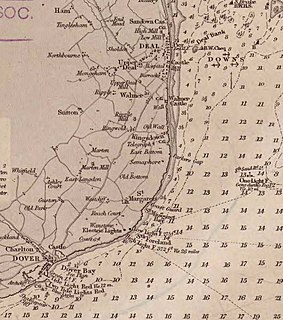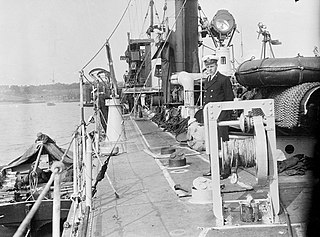
The Downs is a roadstead in the southern North Sea near the English Channel off the east Kent coast, between the North and the South Foreland in southern England. In 1639 the Battle of the Downs took place here, when the Dutch navy destroyed a Spanish fleet which had sought refuge in neutral English waters. From the Elizabethan era onwards, the presence of the Downs helped to make Deal one of the premier ports in England, and in the 19th century, it was equipped with its own telegraph and timeball tower to enable ships to set their marine chronometers.

Goodwin Sands is a 10-mile-long (16 km) sandbank at the southern end of the North Sea lying 6 miles (10 km) off the Deal coast in Kent, England. The area consists of a layer of approximately 25 m (82 ft) depth of fine sand resting on an Upper Chalk platform belonging to the same geological feature that incorporates the White Cliffs of Dover. The banks lie between 0.5 m above the low water mark to around 3 m (10 ft) below low water, except for one channel that drops to around 20 m (66 ft) below. Tides and currents are constantly shifting the shoals.

HMS Ambuscade was an Acasta-class destroyer of the Royal Navy and was launched in 1913. She served throughout the First World War, forming part of the Grand Fleet and taking part at the Battle of Jutland, serving in the Dover Patrol and spending the latter part of the war as a convoy escort. She was sold for scrapping in 1921.

The Second Battle of Dover Strait was a naval battle of the First World War, fought in the Dover Strait in April 1917 and should not be confused with the major Battle of Dover Strait in 1916. Two Royal Navy destroyers defeated a superior force of German Kaiserliche Marine torpedo boats. Two German torpedo boats were sunk; the British suffered damage to both destroyers.

Ramsgate railway station serves the town of Ramsgate in Thanet in Kent, England, and is at least 10 minutes' walk from the town centre. The station lies on the Chatham Main Line, 79 miles 21 chains (127.6 km) down the line from London Victoria, the Kent Coast Line, and the Ashford to Ramsgate line. The station is managed by Southeastern, which operates all trains serving it.

Margate railway station serves the town of Margate in Thanet, Kent, England. It is 73 miles 69 chains (118.9 km) down the line from London Victoria. Train services are provided by Southeastern.

The First Battle of Sirte was fought between the British Royal Navy and the Regia Marina during the Mediterranean campaign of the Second World War. The engagement, largely uneventful, took place on 17 December 1941, south-east of Malta, in the Gulf of Sirte.

HMS Laforey was the lead ship of her class of destroyer built for the Royal Navy. Launched a year before the First World War began, she was attached to the Dover Patrol. Laforey saw action in several engagements with German torpedo boats, including the Battle off Noordhinder Bank and the Action of 17 March 1917. Laforey was sunk in 1917 by a British mine after escorting several freighters to France. She was named for Francis Laforey, captain of HMS Spartiate at the Battle of Trafalgar in 1805.
SMS G37 was a 1913 Type Large Torpedo Boat of the Imperial German Navy during World War I, and the 13th ship of her class.
SMS V46 was a 1913 Type Large Torpedo Boat of the Imperial German Navy during World War I, and the 22nd ship of her class.

The Battle off Noordhinder Bank on 1 May 1915 was a naval action between a squadron of four British naval trawlers supported by a flotilla of four destroyers and a pair of German torpedo boats from the Flanders Flotilla. The battle began when the two torpedo boats were sent on a rescue mission and ran into a British patrol. The Germans fought with the patrolling trawlers until British destroyers from Harwich Force came to their aid and sank the vessels.

The Battle of Dover Strait that occurred on 26–27 October 1916 was a naval battle of the First World War between Great Britain and the German Empire. Two and a half flotillas of German torpedo boats from the Flanders Flotilla launched a raid into the Dover Strait in an attempt to disrupt the Dover Barrage and destroy whatever Allied shipping could be found in the strait.
HMS Paragon was an Acasta-class destroyer that served in the Royal Navy during the First World War. She was launched in 1913, and joined the 4th Destroyer Flotilla upon completion. Serving with the Grand Fleet in August 1914, Paragon moved to the Humber in the summer of 1916, then to Portsmouth, then to Devonport by 1917. On 17 March 1917, fighting alongside HMS Llewellyn in an action in the Dover Strait with eight German torpedo boats, Paragon was sunk by torpedo.

The German destroyer Z4 Richard Beitzen was one of four Type 1934 destroyers built for the German Navy (Kriegsmarine) during the mid-1930s. Completed in 1937, the ship spent most of her time training although she did participate in the occupation of Memel in early 1939. At the beginning of World War II in September 1939, the ship was initially deployed to blockade the Polish coast, but was soon transferred to the Kattegat where she inspected neutral shipping for contraband goods. In late 1939 and early 1940, the ship laid two offensive minefields off the English coast that claimed 17 merchant ships. Z4 Richard Beitzen was in reserve during the Norwegian Campaign of early 1940 and was transferred to France later that year, where she made several attacks on British shipping.

The Action of 28 January 1945 was an inconclusive naval battle of the Second World War fought between two British Royal Navy light cruisers and three Kriegsmarine destroyers near Bergen, Norway. The battle was the last of many actions between British and German warships off Norway during the war and the second-to-last surface engagement to be fought by the Kriegsmarine. It resulted in heavy damage to one of the German destroyers and light damage to another destroyer and both British cruisers.

HMS Valentine was a V and W-class destroyer, built in 1917 for the Royal Navy. She fought in both world wars, serving in several capacities. She was heavily damaged by air attack and beached in 1940 near Terneuzen. Her hulk remained there until it was broken up in 1953.

HMS Vesper was a V-class destroyer of the British Royal Navy that saw service in World War I and World War II.
SMS G96 was a large torpedo boat of the Imperial German Navy that was built and served during the First World War. She was the prototype ship of the 1916 Mobilisation Type torpedo boats, and was launched at Germaniawerft's Kiel shipyard on 19 September 1916, completing in December that year.

SMS V47 was a V25-class Large Torpedo Boat of the Imperial German Navy that was built and served during the First World War.
SMS S34 was a V25-class large torpedo boat of the Imperial German Navy that served during the First World War. She was built by the Schichau-Werke shipyard in Elbing, East Prussia in 1913–1914 and was completed in being launched on 4 April 1914 and was completed in November 1914.















